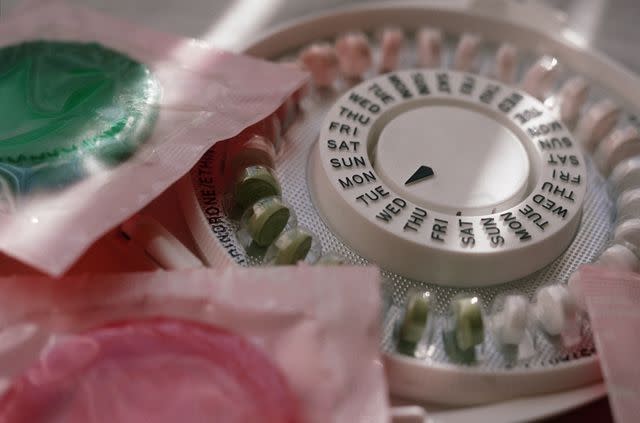5 Things You Need to Know About Birth Control

Tetra Images / Getty Images
The pill seems like the perfect birth control solution: take it at the same time every day and you won’t get pregnant. Simple, safe and effective—no wonder over 26% of women rely on it as their preferred prophylactic.
In reality, most women have very little information about their prescription—other than it reduces the chances of unplanned pregnancy. So you may not know about the added benefits of the pill—including less painful menstrual cramps, a lighter flow and even cleared up acne. These can be life changing for women suffering from severe PMS, endometriosis and other reproductive issues.
There are also many varieties of the pill and each type can affect users in different ways. For instance, progestin-only pills or combination pills made with estetrol (a plant-based estrogen) may benefit people who can't tolerate ethinyl estradiol, the synthetic estrogen found in most combination birth control pills.
Know all your options before settling on one method or (even worse) deciding to forgo contraception altogether.
There Are More Options Than the Pill

External condoms may be the first to come to mind, but there are many other methods that work in similar ways to the pill. Non-oral hormonal contraceptives often have the same benefits as the pill but have fewer side effects or complications (like forgetting to take it).
The Patch
A beige, two-inch square piece of sticky plastic, the patch releases hormones through the skin and works for a week at a time.
With the similar side effects and benefits, the Patch is great for women who have trouble remembering to pop that pill every day. It’s easy to use, though some women complain it falls off too easily.
The Implant
Placed under the skin of your arm, this contraceptive uses progestin to suppress ovulation. The device—about the size of a matchstick—is inserted and removed by a professional with the use of local anesthetic and lasts three years.
There are side effects including irregular bleeding, mood changes, acne, weight gain and changes in sex drive, but these often subside after a few months. The implant offers long-term protection that you rarely have to think about.
The Ring
This device is the size and shape of a hair-tie and can be inserted at home. It works in month-long cycles, remaining in the vagina/front hole for three weeks and removed for the fourth.
Women dissatisfied with other methods often prefer the Ring, as it’s the lowest level of hormones and has fewer side effects. Most people can’t feel it, but it can be removed for sex and remains effective if replaced within 24 hours.
The Shot
Another long-term solution that uses progestin, the Shot is an injection that is effective for three months. It is easy to use, safe for breastfeeding women and has the added benefit of being totally discrete.
Changes in mood, appetite and blood-flow are sometimes reported, but side effects usually subside within six months.
IUD
Intrauterine devices are hormone-free copper or synthetic progestin devices that are surgically inserted into the cervix. These work for between three and 12 years and are safer for smokers and those with high blood pressure than other hormonal methods.
It’s almost impossible to get this one wrong, though cramps, spotting and increased blood-flow are possible side effects. Another bonus, it can be used while breastfeeding.
Gel
Phexxi is a non-hormonal birth control option that comes in the form of a gel. It must be inserted vaginally/in the front hole before sex and works to change the pH of the vagina/front hole during sex to prevent pregnancy. Phexxi was approved by the FDA in 2020.
Try, Try Again

Peter Dazeley / Getty Images
Thanks to fluctuating hormones, women’s bodies change from their teens to their 20s, 30s, 40s and so on. Side effects can start—or end—years into any given regimen.
So if you suddenly start gaining weight or notice your skin clearing up years after taking YAZ, it’s not the formula that’s changed; it’s you. Obesity has also been linked to a slight decrease in effectiveness.
You can switch up methods of birth control over time as your lifestyle and body changes.
If you’re going to try to start a family in the next year or two, your IUD or implant may not be the best choice.
Women who are smokers, over 35 or at high-risk for breast cancer are encouraged to try contraceptives with lower hormone levels and to take breaks from long-term methods.
Whether you’ve been using the same method for a while or if you’re not totally satisfied, talk to your healthcare provider about alternatives.
Most Birth Control Has Side Effects

Eric Audras / Getty Images
Medical history is the most important factor when choosing contraceptives and can determine possible side effects.
The pill is not recommended for smokers. Oral contraceptives are less safe to take for those with a history of migraines, diabetes, stroke or heart disease, as the ingredients may increase the risk of blood clots and high blood pressure.
Even if your healthcare provider has given you the all-clear, the pill can have side effects that may surprise you. The most common are bleeding, nausea, vaginal/front hole infections, decreased libido, high blood pressure, headaches, bloating, weight gain and depression. These should subside within a few months.
More serious but rare side effects include blood clots, heart attacks, stroke and cervical cancer. Your contraceptive can also interfere with other medication, so if you experience unusual and unpleasant changes, talk to your healthcare provider about trying something new.
You Still Need a Condom

Condoms are the only contraceptives that also protect against STIs. This means that unless both you and your partner test free of any infection and are in a monogamous relationship, you must always wear a condom.
Just like the pill, there are many kinds of condoms—latex-free, lubricated and non-lubricated depending on your preference. And size does matter! Most brands have various sizes and malfunction most commonly occurs because of improper fit, so it’s important that your condoms have a snug fit.
You Can't Slack Off

Carelessness with oral contraceptives accounts for almost half of all unplanned pregnancies. No, you can’t miss “just one or two days” and proceed as normal. Even if missing a day or two doesn’t result in a baby, inconsistency can lead to fluctuations in hormones making side effects worse.
Whatever you do, don’t double up if you miss a dose! This can have seriously un-fun consequences like excessive bleeding, headaches and emotional changes . If you forget a pill, resume taking as normal and make sure to use a secondary method of birth control for at least a week afterwards.
A Word From Verywell
Though all this information may seem overwhelming, it’s crucial to have the facts when choosing something as important as birth control. Thankfully, there are many options available for short and long-term use, so if one (or three!) methods aren’t for you, you’re sure to find one that is if you keep trying.

